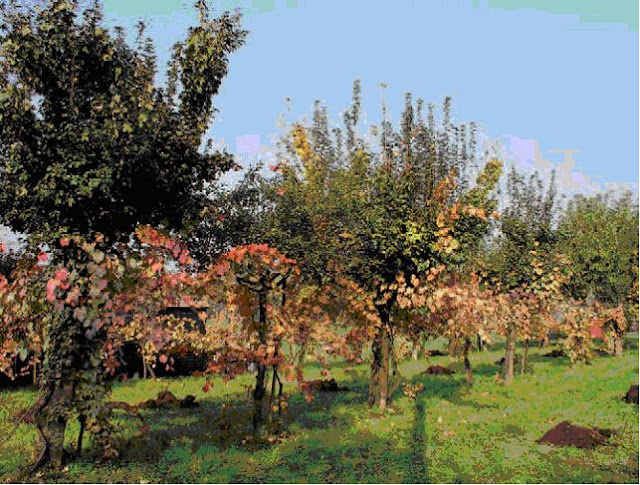IDEE SULLA VITE MARITATA
UN PERCORSO A RITROSO
ALLA RICERCA DELLE RAGIONI DELLA PERSISTENZA DELLA VITE MARITATA
SUPPONIAMO CHE LA POSIZIONE, LA GIACITURA DI UNA VITE, PIANTA COSI’ IMPORTANTE ORA E NELL’ANTICHITA’, NON SIA STATA DETTATA ESCLUSIVAMENTE DA MOTIVAZIONI AGRONOMICHE ED ECONOMICHE, MA AVESSE IN ANTICO ANCHE UNA FUNZIONE , PER COSI’ DIRE, SACRALE, RISPONDESSE , CIOE’, A CRITERI SUGGERITI O RINFORZATI DAL RAPPORTO CON LA DIVINITA’……..
SE IL CONFINE E’ SACRO, NON LO POSSO SUPERARE PENA LA PUNIZIONE DIVINA.
SE IL CONFINE E’ SACRO, O, IN ALTRA E DIVERSA MISURA, LA PIANTA E’ SACRA, NON POSSO SVELLERLA, SPIANTARLA.
ALLORA LA PIANTA GODE DI PROTEZIONE DA PARTE DELLE LEGGI DEGLI UOMINI E DA PARTE DELLE LEGGI DIVINE. LA PROTEZIONE E’ RINFORZATA.
FACCIAMO UN PASSO IN AVANTI: SE PONGO LA VITE AL CONFINE GODE DI PROTEZIONE IL CONFINE E GODE DI PROTEZIONE LA PIANTA, ANCHE AL DI FUORI DI UN BOSCO SACRO O DI UN RECINTO SACRO.
IN EFFETTI MOLTE VITI MARITATE ANCORA SUSSISTENTI SONO POSTE SUL CONFINE……..
CERCHIAMO CONFORTO, ANCORA UNA VOLTA, NELLE FONTI, UNA FRA LE TANTE:
“ LE FIGLIE DI ANIO – FIGLIO DI APOLLO – ELAIDE,SPERMO ED ENO ERANO DETTE ENOTROFI POICHE’ DIONISO AVEVA LORO DONATO LA FACOLTA’ DI PRODURRE DALLA TERRA OLIO, GRANO E VINO.
(APOLLODORO – BIBLIOTECA – EPITOME – 10 E SS.)
ED ANCORA:
“DIONISO SCOPRI’ LA VITE, MA, RESO FOLLE DA ERA, ANDO’ VAGANDO PER L’EGITTO E LA SIRIA (SI BADI AI LUOGHI DI NASCITA DELLA VITICOLTURA, NDR).
IN FRIGIA REA LO LIBERO’ DALLA FOLLIA E GLI INSEGNO’ RITI MISTERICI……… “.
“DIONISO INFUSE FOLLIA IN LICURGO, FIGLIO DI DRIANTE, RE DEGLI EDONI, CHE ABITANO LUNGO IL FIUME STRIMONE IN TRACIA.
LICURGO CONVINTO DI COLPIRE UN TRALCIO DI VITE PERCOSSE CON UNA SCURE E UCCISE IL PROPRIO FIGLIO DRIANTE POI DOPO AVERE RECISO LE ESTREMITA’ DEL FIGLIO, TORNO’ IN SENNO.
LA TERRA SMISE DI PRODURRE FRUTTI E IL DIO VATICINO’ CHE ESSA SAREBBE TORNATA A DARE IL RACCOLTO SE LICURGO FOSSE STATO GIUSTIZIATO, COSA CHE AVVENNE PER VOLONTA’ DI DIONISO. MORI’ DILANIATO DAI CAVALLI” .
APOLLODORO- BIBLIOTECA – LIBRO TERZO )
ORA SECONDO ALTRE VERSIONI (IGINO, SERVIO E I MITOGRAFO VATICANO) IL RE FOLLE NEL TENTATIVO DI TRANCIARE LE VITI SI MOZZO’ LE GAMBE.
DICE FRAZER IN NOTA CHE E’ CREDENZA COMUNE CHE QUANDO UN BOSCAIOLO TAGLIA UN ALBERO SACRO CON UNA SCURE COLPISCE SE STESSO NEL MEDESIMO GESTO.
( CFR.: W. MANNHARDT, DER BAUMKULTUS, BERLINO, 1935)
FRAZER HA AFFRONTATO PIU’ VOLTE IL TEMA DELL’ALBERO SACRO, DELLA VITE SACRA ANCHE NEL RAMO D’ORO.
INNUMEREVOLI LEGGENDE DI CONTENUTO SIMILE NELLA CULTURA EUROPEA ANTICA E NEL FOLKLORE MODERNO, NELLA LETTERATURA E NELLA FAVOLISTICA.
TRACCE DI ELEMENTI RELIGIOSI ANCHE IN EPOCA STORICA IN MATERIA PATRIMONIALE "SONO INDIVIDUATE NEI "TERMINI", NEL CERIMONIALE DELLA LIMITATIO, NEL CERIMONIALE DELL'APPOSIZIONE DEI TERMINI, NELLA SANZIONE DELLA "CONSECRATIO" CONTRO CHI LI SMUOVE.
PROBABILE CHE CONCEZIONI RELIGIOSE E CREDENZE MAGICHE POSSANO AVER CONTRIBUITO ALLA FORMAZIONE DEL CONCETTO GIURIDICO ROMANO DELLA PROPRIETA' ASSOLUTA, INDIPENDENTE."
COSI' IN: DEFRANCISCI P. STORIA DEL DIRITTO ROMANO, GIUFFRE', 1942 P. 373












